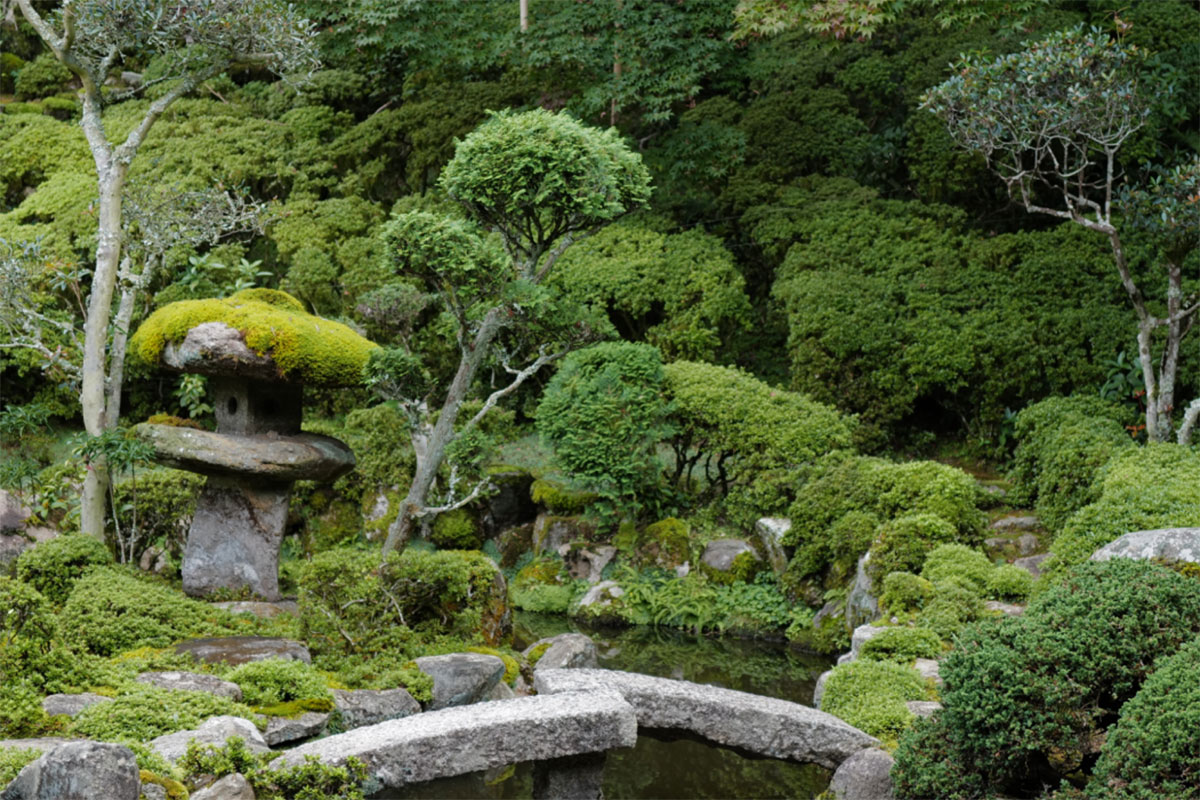If you have ever enjoyed an afternoon in a Japanese public garden, you know that the experience feels transcendent. Koi ponds give way to carefully pruned cherry blossom trees or an outdoor bonsai garden. A simple walkway, shadowed by bamboo, encourages reflective silence. Every minute feels like a reset for the body and mind.
In recent years, Japanese-style landscaping has become increasingly popular in home gardens as well, bringing its signature simplicity to outdoor spaces of all shapes and sizes. We asked Jake Hobson, the founder of the Japanese gardening tool brand Niwaki (and resident KonMari gardening expert), to walk us through what defines Japanese garden style and a few tips on how to use it as inspiration in the home garden.
Japanese Garden Style: An Introduction
Traditional Japanese gardens pay tribute to the nation’s history of philosophy, culture and aesthetics. There are two distinct categories of Japanese gardens: those intended for tranquil reflection and those for walking or strolling. They feature plants native to Japan — like black and red pine or maple trees, moss, camellia and yew — and plenty of open space. These unplanted areas nod to yohaku no bi, or the beauty of empty space, which is “a reminder of the infinite potential that dwells within nature — and each of us.”
Most gardens also embrace the concept of wabi-sabi, the beauty of imperfection. Plants and materials are allowed to age gracefully, giving each Japanese garden its own unique, organic ambiance.
“I think Japanese gardens resonate so deeply with people because they create a sense of place,” Jake says, “There is a stillness and grounding. From large palace gardens to tiny courtyards, the Japanese approach immerses the viewer visually and emotionally, subconsciously transporting them to another place.”
Japanese Gardening at Home
While Japanese gardens are unique to Japan and its history, they can still inspire your garden design. Here are five tips for creating a tranquil private garden with a deep sense of place.
1. Focus on Feel
Long before you head to your local nursery, consider how you’d like to feel in your home garden. Ask yourself open-ended questions like:
- When you’ve spent time in nature, where have you felt your calmest?
- Does your ideal garden include a place to read or enjoy an afternoon tea ritual?
- Does it include plants or flowers that you can cut and bring indoors?
A garden should fit within your kurashi, or ideal lifestyle. Give yourself plenty of time to decide what a garden means to you — and commit to planting what sparks joy for you!
2. Honor Your Surroundings
Japanese gardens draw inspiration from their surroundings — a technique that makes them feel more grounded in the present. “Interestingly, there are similarities between Japanese garden style and certain North American styles,” says Jake, “Especially where native plants and landscapes are often the sources of inspiration — notably the Pacific Northwest and the arid gardens of the Southwest.”
Rather than forcing a design onto the landscape, let the landscape inspire your design. Choose plants that will thrive in your surroundings. Give plants plenty of room to grow, leaving enough space for their mature size. And don’t be afraid to leave some areas unplanted — the beauty of empty space.
Joyful Tip: Native plants also attract local species of butterflies and other pollinators, some of which won’t visit non-native species!
3. Embrace the Process
Japanese gardens respect the slow changing of the seasons — and weather any unexpected storms. Rather than avoiding plants that will take a few months or years to grow, lean into the process. “Plants take time, not just to grow, but for you to understand how they grow, to learn to get the best out of them,” says Jake. “Keep it simple, and don’t rush. Notice and appreciate the seasonal changes.”
As you wait for perennials, trees or shrubs to mature, you can co-plant a few annuals in the same beds to spark joy this year. Or try your hand at an indoor garden or ikebana to pass the time!
4. Learn Some Japanese Gardening Techniques
The best way to experience the style of Japanese gardens is to visit them. “To get inspired and build up knowledge and inspiration, I suggest making regular trips to local gardens and local countryside,” Jake says. “Bring a good old-fashioned plant book along for identifying species.”
If you’re not lucky enough to have a Japanese garden nearby — or if you’d like to explore further — there are plenty of online resources for budding gardeners. Jake recommends The North American Japanese Garden Association (NAJGA) and The Aesthetic Pruners Association (APA), which combines Japanese pruning techniques and practical solutions for tree and shrub care. Or try a gardening book! Jake has written two: ”Niwaki” and “The Art of Creative Pruning.”
5. Make Mistakes
No garden — not even a traditional Japanese garden — is perfect. Japanese garden style embraces these imperfections, and so should you!
“You’ll make mistakes,” says Jake, “Even if it’s not your fault, plants will die — it happens with everyone! Learn from those mistakes, learn from others, and learn to look at and appreciate it all.”
Ask any avid gardener: Embracing the unexpected can lead to countless joys.








